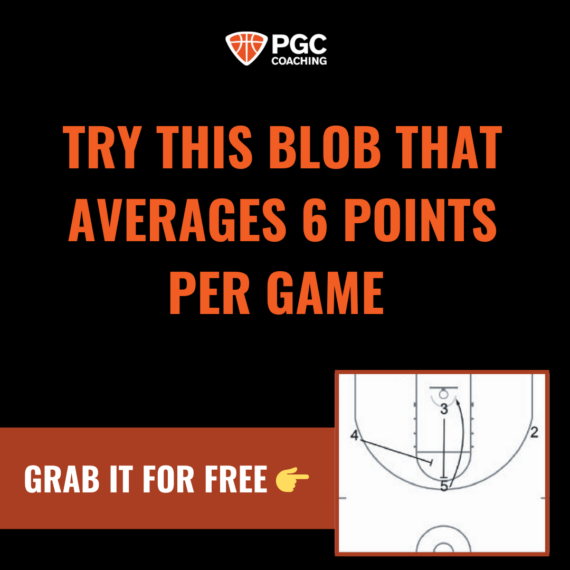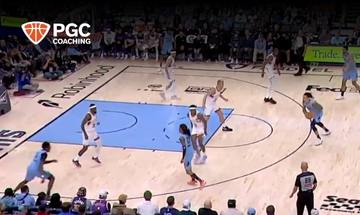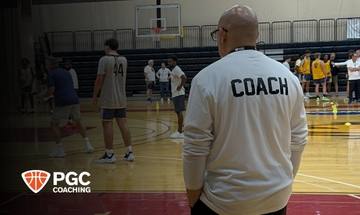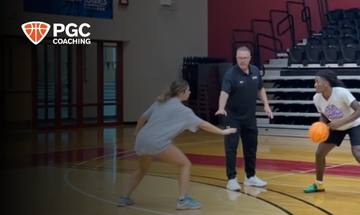How to Teach the Read & React Offense in 5 Simple Steps
I get this question all the time: “How should I teach the Read & React Offense?”
And here’s my honest, maybe slightly frustrated, answer: You have to run the Read & React to improve at the Read & React.
Meaning…
You can’t get good at something you’re not committed to, and you can’t improve without going through the growing pains.
Now that I’ve gotten that off my chest, let me walk you through the 5-step progression I recommend to every coach.
And if you’re looking for more Read & React resources, check these out:
- The Truth About 5 Out (And Every Other Formation in Read & React)
- Why I Spent 12 Straight Practices on the Read & React (and Didn’t Teach Defense)
Step 1 to Teaching the Read & React Offense: Start with 3-Player Reaction Drills
The first 15 minutes of your practice should be dedicated to the foundational habits of the Read & React. The best way to install these habits?
3-player drills.
They’re fast. They’re efficient. And they maximize reps.
Choose 8–10 drills based on the layers you’re working on. Run each drill for just 90 seconds. That’s enough time to build muscle memory without bogging practice down.
By the way, I don’t treat this time as a separate block. This is your warm-up. This is your skill development. This is your shooting time.
If I only had 15 minutes for practice, this would be my entire plan.
Repetition creates reaction. Reaction builds instinct. Instinct wins games.
Step 2 to Teaching the Read & React Offense: Go 5-on-0 Without Shooting
Once the habits are starting to stick, move into 5 vs 0 dry runs.
No defense. No shots. Just clean execution.
Your players should be able to Pass & Cut without hesitation and errors. Once that’s clean, begin layering in additional actions—again, no shots, no defense, just movement and flow.
I’d give each group 5 minutes. If you have multiple courts or baskets, get groups working simultaneously. If not, rotate quickly and keep everyone moving.
If your team can’t run a layer without defenders, they won’t succeed with them.
Step 3 to Teaching the Read & React Offense: 5-on-5 With Dummy Defenders
Now it’s time to introduce structure and pressure, without full chaos.
Run 5-on-5 with defenders on the floor, but with a couple rules:
- Offense cannot shoot.
- Defense cannot steal, block, or disrupt passes.
This forces your team to execute movement with awareness of defense and without worrying about scoring just yet. It also helps develop spacing, timing, and trust.
Focus only on the layers your team has already mastered in Step 2. If you’re still developing Layer 3, don’t run it here. Stick with Layers 1 and 2.
I’d spend 15–20 minutes in this phase, because this is where your team learns how to operate in the half-court under game-like conditions.
Sharpen your half-court offense. Sharpen your half-court defense. Do both at once.
Step 4 to Teaching the Read & React Offense: Add a Semi-Live Drill Like the Deflection Game
Once your team looks confident, it’s time to add chaos and consequences—but in a controlled way.
Use a semi-live drill like 5-on-5 with modified rules and specific goals.
Spend 5 minutes with each group on both sides of the ball. It’s a great way to challenge your offense and sharpen your defense without going fully live.
Drills like this help close the gap between practice and performance.
Step 5 to Teaching the Read & React Offense: Go Live — 5-on-5 Full Contact
This is where you test your progress and find your weaknesses.
Let your team play full 5-on-5. Let the defense play real. Let the offense make decisions. But don’t expect perfection. That’s not the point.
If players start freezing…
If the flow breaks down…
If they don’t know where to go next…
That’s your cue to take a step back and drill more.
For reference, you might spend 10 minutes going live in the half-court. Adjust based on your team’s level.
What’s the Time Breakdown?
| Phase | Time |
|---|---|
| Step 1: 3-Player Drills | 15 min |
| Step 2: 5-on-0 | 15 min |
| Step 3: Dummy Defenders | 15–20 min |
| Step 4: Semi-Live Drill | 10 min |
| Step 5: Full 5-on-5 Live | 10 min |
That’s about an hour total, and your team is now practicing the offense, not just learning about it.
Use the rest of your practice to work on transition, press break, special situations, or other needs unique to your team.
Soapbox Moment
Let me be clear:
You can’t get good at anything by spending 5–10 minutes on it.
The Read & React Offense isn’t just a playbook you run. It’s a complete system.
If it’s not a regular part of your practice, it won’t become your team’s default behavior. If it’s not how you train daily, it won’t show up when the lights come on.
The Read & React Offense must become how your team plays—every possession, all the time.
FAQ: Teaching the Read & React Offense – Your Top Questions Answered
Q: Is the Read & React Offense hard to teach at the youth or high school level?
A: Not at all—when taught in layers, the Read & React Offense is ideal for youth and high school programs. Starting with simple 3-player drills and building up to full 5-on-5 makes it accessible and progressive. The key is consistency—train it daily so the habits become second nature.
Start small with Layer 1 drills, and build from there—your players will adapt faster than you think.
Q: What are the foundational habits of the Read & React Offense?
A: The core habits include Pass & Cut, Drive & Space, Circle Movement, and Post Passing Reactions. These are installed early through 3-player drills and expanded with each practice. Teaching the habits first ensures players react instinctively in live action.
Focus on habits before complexity. Get our top 10 drills to build Read & React habits fast.
Q: Why do you start with 3-player drills instead of team-wide actions?
A: Because reps build reactions. Small-group drills increase touches, repetitions, and confidence. They allow players to master specific actions without getting lost in 5-on-5 chaos too early. It’s the most efficient way to build timing and instinct.
Looking for the most effective Read & React warm-up? Use 90-second 3-player drills to kick off every practice.
Q: When should I introduce shooting into the drills?
A: Wait until players have mastered clean movement and spacing. During Steps 1–3, eliminate shooting to keep the focus on cutting, decision-making, and positioning. Once players are executing the actions without confusion, introduce shots in semi-live or full-live phases.
Let movement lead the way—shots are more effective when the actions flow naturally.
Q: What’s the biggest mistake coaches make when teaching Read & React?
A: Trying to teach too many layers too quickly. The system works best when layered slowly, with ample reps at each stage. If your players struggle in live play, it often means a prior step was skipped or rushed. Simplify, then progress.
Feeling overwhelmed? Stick with 1–2 layers per week and trust the build-up process.
Q: How do I know when my team is ready to go live?
A: You’ll see it in their confidence and communication. If they can move fluidly through your first 2–3 layers without freezing or breaking spacing, they’re ready for controlled chaos. Start with semi-live, then move to full-contact 5-on-5.
Watch for timing, spacing, and instinct—those are your green lights for live action.
Q: Can I run this progression in just 60 minutes?
A: Yes—this 5-step method was designed for efficient practices. You’ll cover 3-player skill reps, dry 5-on-0 execution, dummy defense, semi-live drills, and full-speed action—all within an hour. Add transitions or specials with any extra time.
Try the 60-minute Read & React blueprint and see your players’ game IQ explode.
Q: What does success look like during the install?
A: It’s not perfection—it’s progressive flow. You’re looking for players to recognize cues and take action without hesitation. That might mean a clean basket cut, a fill behind, or relocating off a drive. Build fluency, not plays.
Measure your team’s success by their ability to move without thinking—not just make plays.
Q: What resources do you recommend for learning and teaching this offense?
A: We recommend starting with drill videos, install plans, and community insight from coaches who’ve successfully installed the system. Inside the PGC Coaching Community, you’ll find curated Read & React training, layer breakdowns, and planning tools.
Get access to exclusive Read & React training—start your free 7-day trial today.
Final Thought
The Read & React Offense is more than a system—it’s a philosophy of player development and decision-making. When taught with intention, it becomes your team’s natural language on the court. Use these five steps to get started—and if you want a complete install plan and coaching support, the PGC Transformational Coaches Community is here to help.
Get 7 days of FREE access to the entire Read & React offense inside our paid PGC Coaching membership.
Coach Rick
Check more Read & React resources here.
About the Author
Rick Torbett
Rick Torbett, creator of the Read & React Offense, has dedicated over 40 years to revolutionizing the game of basketball. His innovative methods have earned him recognition as a mentor to coaches and players in more than 100 countries.
Throughout his two decades coaching high school teams, Coach Torbett developed systematic approaches to mastering the fundamentals—shooting, ballhandling, passing, and more. His expertise attracted athletes of all skill levels, from aspiring All-Americans to those preparing for NBA tryouts.
A trailblazer in the world of basketball, Coach Torbett blends personal experience with groundbreaking techniques to inspire players and coaches to unlock their full potential, transforming teams and careers along the way.
New Here?
Get coaching tips and tools like these delivered to your inbox each week!
Join the 15,000 coaches we’ve assisted…

Related Articles
The Truth About 5 Out (And Every Other Formation in Read & React)
Discover why the Read & React Offense breaks all the rules about spacing and formations — and how motion turns every player into an inside threat. Ready to rethink your offense?
Why I Spent 12 Straight Practices on the Read & React (and Didn’t Teach Defense)
Why I scrapped defense for 12 practices. I went all-in on the Read & React Offense—and it changed everything. Here’s what I learned.
How to Build Basketball Shooting Consistency: The Missing Feedback Every Coach Needs
Discover why players shoot well in practice but not in games, and how measurable shot feedback can fix it. Learn simple ways to add clarity, improve consistency, and use tools like Noah Basketball to turn practice reps into real, game-time results.
About PGC
PGC Basketball provides intense, no-nonsense basketball training for players and coaches. Our basketball camps are designed to teach players of all positions to play smart basketball, be coaches on the court, and be leaders in practices, games and in everyday life.
We combine our unique PGC culture with a variety of teaching methods and learning environments to maximize the learning potential of those that attend our sessions. In addition to spending 6-7 hours on the court each day, lessons will be reinforced through classroom sessions and video analysis.
Our goal at PGC is to empower you with the tools to fulfill your basketball dreams, while also assisting you in experiencing the joy of the journey.
To learn more about PGC Basketball, including additional basketball training tips and videos, visit our YouTube Channel or find us on Facebook, Instagram, and Twitter.






Share This Post